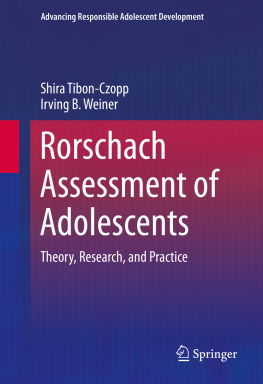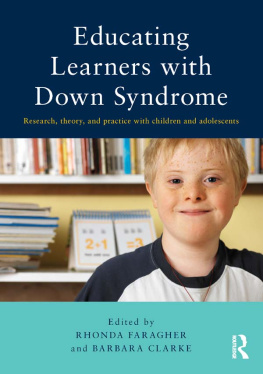1. Historical Foundations of the Rorschach Inkblot Method
According to available reports, Hermann Rorschach, a Swiss psychiatrist born in 1885, had been exposed to inkblots as an adolescent, in the form of a popular parlor game called Klecksographie . Klecks is the German word for blot, and the Klecksographie game was played by dropping ink in the middle of a piece of paper, folding the paper in half to make a more or less symmetrical blot, and then competing to see who among the players could generate the most numerous or interesting descriptions of the blots or associations to what they resembled.
From 1917 to 1919, while serving as Associate Director of the Krombach Mental Hospital in Herisau, Switzerland, Rorschach pursued a notion he had formed earlier in his career that patients with different types of mental disorders would respond to inkblots differently from each other and from psychologically healthy people. To test this notion, he constructed and experimented with a large number of blots. Nevertheless, unlike the formless inkblots of the parlor game that were made by dropping the ink on a blank sheet of paper, the blots with which he experimented were carefully drawn by him, and over time he selected a small set that seemed particularly effective in eliciting responses and reflecting individual differences. The original blots drawn by Rorschach, who was a talented artist, have been on display in the Rorschach Archives and Museum in Bern, Switzerland, since September 2000. In June 2012, there was a fire in the upper floor of the building in which the archives and museum were located. Although none of the items in the collection was damaged, they had to be removed from the building and are currently being stored in the Institute of the History of Medicine in Bern.
Rorschach administered his selected set of blots to samples of patients and nonpatients, using a standard instruction ( What might this be ?), and he published his findings from this research in the form of a monograph titled Psychodiagnostics: A Diagnostic Test Based on Perception (Rorschach, ). The monograph was a preliminary work and initially did not attract much attention. Nevertheless, the materials and methods described by Rorschach in Psychodiagnostics have provided the basic foundation for the manner in which Rorschach assessment has been most commonly practiced since that time, and the standard Rorschach cards currently in use are the same ten inkblots that were published with Rorschachs original monograph.
As elaborated in this chapter, the subsequent early years of Rorschach development produced what might be defined as Confusion of Tongues. The differing methods of administration and coding prevented clear communication among Rorschach scholars and clinicians and systematic accumulation of research findings. To address these problems, John Exner developed the Rorschach Comprehensive System (CS), which was originally published in 1974 and provided a standardized method of Rorschach assessment that became widely adopted method. The discussion that follows reviews the continuing evolution of the CS, its enrichment by psychodynamic conceptualization, and its utility for validating the Rorschach method.
Early History: Confusion of Tongues
Between the two world wars, Switzerland was an internationally prominent education and training center for medical scientists and researchers. Some of the scholars and practitioners who visited Swiss institutions in those years were told about Rorschachs method and took copies of the inkblots home with them. One of these visiting scholars was an American psychiatrist, David Levy, who brought several sets of the inkblots back to New York and suggested to Samuel Beck, then pursuing his psychology doctorate at Columbia, that he considered doing his dissertation with the Rorschach. Beck accepted this suggestion and undertook as his doctoral research a standardization study of Rorschach responses in children.
While collecting his data, Beck published the first English language article on the Rorschach method (Beck, ). In 1934, Beck went to Switzerland for conducting a study with Emil Oberholzer, who had been a close friend and colleague of Rorschach, and his departure coincided with the arrival from Zurich of Bruno Klopfer, who had received a doctorate in educational psychology in 1923 and by 1933 had advanced to a senior staff position at the Berlin Information Center for Child Guidance. However, the restrictions being placed on Jews in Germany at that time led Klopfer to move to Zurich. Without a job in Zurich, he was helped by Carl Jung to obtain a position as a technician at the Zurich Psychotechnic Institute. Klopfers responsibilities at the Institute included psychological testing of applicants for various types of jobs, and the Rorschach was among the tests he was required to use for this purpose. He had no previous interest or experience in testing, but he soon became intrigued with the ways in which Rorschach responses could reveal the underlying thoughts and feelings of the people he was testing.
Klopfer was dissatisfied with his low-status role as a technician, however, and soon began looking for other opportunities. In 1934 he was appointed as a research associate in the Department of Anthropology at Columbia University. Having learned of his arrival on campus, a group of psychology graduate students asked their department to arrange for Klopfer to give them some Rorschach training. Unimpressed with Klopfers credentials, the department declined to hire him for this purpose. The students were not deterred, however, and they approached Klopfer privately about offering some evening seminars for them in his home. Klopfer agreed to offer the seminars, and the group started to meet for what may have been the first Rorschach workshop.
Giving seminars for this and subsequent groups of students and professionals produced a network of psychologists who were eager to keep in touch with each other and continue exchanging ideas about the Rorschach. In response to this interest, Klopfer in 1936 founded the Rorschach Research Exchange , which has been published regularly since that time as the Journal of Projective Techniques beginning in 1950, as the Journal of Projective Techniques and Personality Assessment beginning in 1963, and since 1971 as the Journal of Personality Assessment . In 1938, Klopfer founded the Rorschach Institute, a scientific and professional organization that continues to function actively today, and more broadly than Klopfer had envisioned, as the Society for Personality Assessment.
Although both Klopfer and Beck gained international acclaim for developing the Rorschach and for pioneering the publication of the English version of guidelines for working with the test (Beck, ), they approached their work from quite different perspectives. Having been educated in an experimentally oriented department of psychology, Beck was interested in describing personality characteristics and was firmly committed to advancing knowledge through controlled research designs and empirical data collection. He stuck closely to Rorschachs original procedures for administration and coding, and he favored a primarily quantitative approach to Rorschach interpretation.







